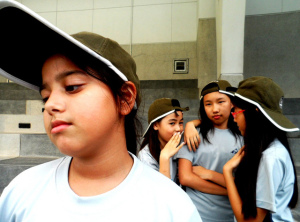Bullying, homophobic teasing, and sexual harassment

Bullying prevention has been a major focus for schools for the past several years, and it can be a good entry point for sexual and dating violence prevention efforts to get into schools. Over the years, there has been more and more support for the “bullying – sexual violence pathway,” a theory that children who bully other children are more likely to perpetrate sexual violence, like sexual harassment, unwanted touching/groping, and maybe even more severe sexual violence, as well as teen dating violence.
New research by Dr. Dorothy Espelage et al. adds another dimension to this pathway that can be important for prevention. They followed almost 1,000 fifth-seventh graders for two years and measured their bullying perpetration and homophobic teasing perpetration as they related to later sexual harassment perpetration. Preventing sexual harassment is a really important goal, since according to another recent study, about 1 in 8 boys and 1 in 20 girls perpetrate sexual harassment in high school. The study found that girls who bullied others at the beginning of the study were over 3 times more likely to sexually harass others two years later, but homophobic teasing didn’t affect this relationship. Boys who bullied others were over 4.5 times more likely to perpetrate sexual harassment than boys who didn’t bully, and boys who engaged in homophobic teasing were 1.66 times more likely to perpetrate sexual harassment than boys who didn’t. Interestingly, if boys engaged in a lot of bullying and a lot of homophobic teasing, they were even more likely to engage in sexual harassment two years later than boys who did both bully and engage in homophobic teasing, but did so rarely.
Clearly, preventing bullying can have a big impact on preventing sexual harassment for both boys and girls. But it looks like it can be important to also focus especially on preventing homophobic teasing by boys. Not only would this focus make a stronger connection between bullying and sexual violence, but it also supports our goals of preventing violence against all people, regardless of gender or sexual orientation, and of challenging oppressive gender roles. If boys can be free from homophobic bullying or gender policing, maybe they’ll be less likely to be hostile toward people and traits they deem feminine and more likely to be openly caring, sensitive, and empathetic.
Full citation: Espelage, D.L., Basile, K.C., De La Rue, L., & Hamburger, M.E. (2014). Longitudinal associations among bully, homophobic teasing, and sexual violence perpetration among middle school students. Journal of Interpersonal Violence. Advance online publication. doi:10.1177/0886260514553113
Link: http://jiv.sagepub.com/content/early/2014/10/10/0886260514553113.abstract
Full abstract:
“Bullying perpetration and sexual harassment perpetration among adolescents are major public health issues. However, few studies have addressed the empirical link between being a perpetrator of bullying and subsequent sexual harassment perpetration among early adolescents in the literature. Homophobic teasing has been shown to be common among middle school youth and was tested as a moderator of the link between bullying and sexual harassment perpetration in this 2-year longitudinal study. More specifically, the present study tests the Bully–Sexual Violence Pathway theory, which posits that adolescent bullies who also participate in homophobic name-calling toward peers are more likely to perpetrate sexual harassment over time. Findings from logistical regression analyses (n = 979, 5th-7th graders) reveal an association between bullying in early middle school and sexual harassment in later middle school, and results support the Sexual Harassment Victimization and Perpetration Among High School Students Bully–Sexual Violence Pathway model, with homophobic teasing as a moderator, for boys only. Results suggest that to prevent bully perpetration and its later association with sexual harassment perpetration, prevention programs should address the use of homophobic epithets.”
